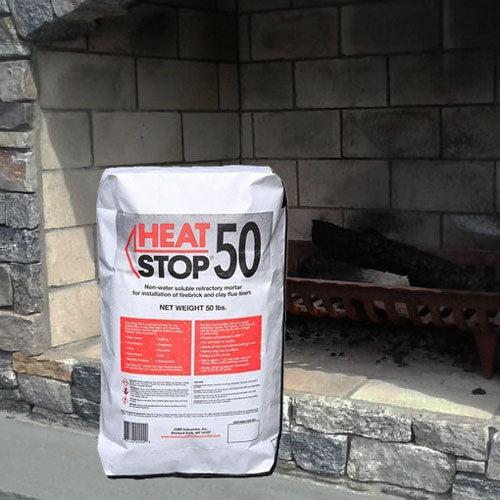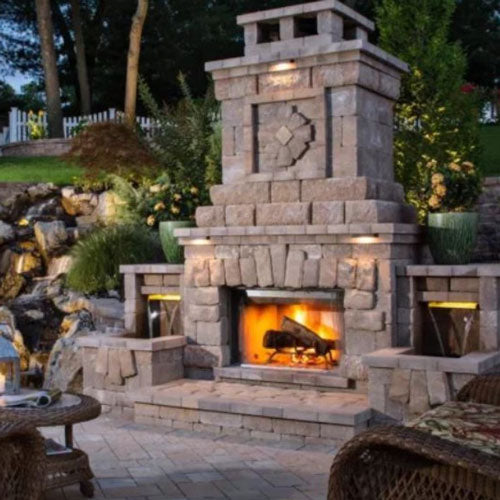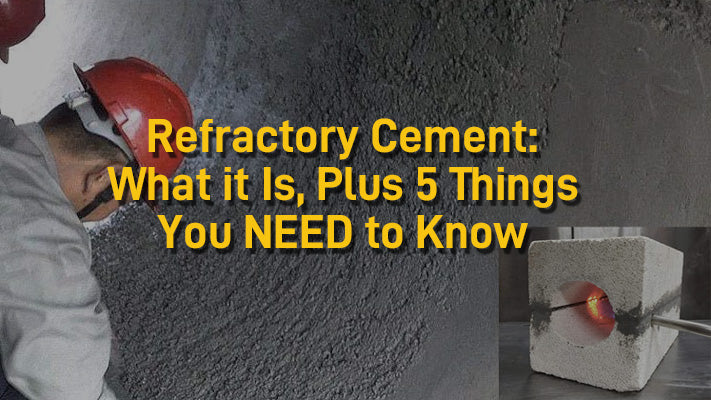A Complete Guide to ASTM C-199 Heat Stop Refractory Mortar: Installation, Benefits, and High-Temperature
Applications for Fireplaces and More
In the realm of high-heat masonry projects, selecting the right refractory mortar is crucial for safety,
durability, and performance. ASTM C-199 Heat Stop Refractory Mortar emerges as a top choice,
offering superior heat resistance and code compliance for fireplaces, chimneys, and ovens. If you're searching for
high-temperature refractory mortar, firebrick installation mortar, or ASTM C-199 compliant solutions, this guide is
your go-to resource. We'll explore its features, benefits, step-by-step installation, and applications, helping DIY
enthusiasts, contractors, and builders achieve reliable, long-lasting results. Discover why Heat Stop Refractory
Mortar is essential for masonry fireplaces exceeding 800°F, providing peace of mind with temperatures well above
2000°F resistance.

Heat Stop Refractory Mortar Easy Mix Bag
What is ASTM C-199 Heat Stop Refractory Mortar?
Heat Stop Refractory Mortar is a specially formulated, ready-to-use mortar designed for bonding firebrick, clay
flue liners, and other refractory materials in high-heat environments. Unlike standard cement or masonry mortar
that fails at 600-800°F, this ASTM C-199 refractory mortar complies with the American Society
for Testing and Materials standard for wet refractory mortars, ensuring it withstands extreme temperatures above
2000°F. Ideal for residential and commercial masonry projects, it's economical, versatile, and easy to apply,
making it a staple for anyone tackling fire-resistant installations.
Its unique composition—typically a blend of refractory aggregates and binders—prevents cracking, spalling, or
degradation under thermal shock, providing a secure seal that maintains structural integrity in chimneys and
fireboxes.

Firebrick Installation Using Heat Stop Mortar
Key Features and Benefits of Heat Stop Refractory Mortar
The standout feature of Heat Stop Refractory Mortar is its exceptional heat resistance, rated
for continuous exposure above 2000°F, far surpassing ordinary mortars. This makes it indispensable for
code-compliant installations in fireplaces operating above 800°F. Its wet, premixed consistency allows for
smooth troweling and strong adhesion without the need for on-site mixing, saving time and reducing waste.
Benefits include superior durability against thermal cycling, which prevents joint failures over years of use.
As an economical option, it offers excellent coverage—typically 50-70 sq. ft. per 10.3 oz tub for 1/8-inch
joints—while being versatile for both interior and exterior applications. For those prioritizing
fire-resistant mortar, Heat Stop ensures safety, ease of use, and long-term performance without
compromising on quality.
- High-Temperature Resistance: Withstands over 2000°F for reliable fire safety.
- Easy Application: Ready-to-use formula minimizes preparation and cleanup.
- Code Compliance: Meets ASTM C-199 for wet refractory mortars in high-heat settings.

Chimney Flue Liner Sealed with Heat Stop Mortar
How to Install Heat Stop Refractory Mortar: A Step-by-Step Guide
Installing with ASTM C-199 Heat Stop Refractory Mortar is straightforward, requiring basic
masonry tools like a trowel and joint tool. This guide ensures professional results for
firebrick installation mortar projects, suitable even for beginners. Always work in a
well-ventilated area and wear protective gear for safety.
- Prepare the Surface: Clean firebricks or flue liners thoroughly to remove dust and debris;
dampen slightly for better adhesion.
- Mix if Needed: As a ready-to-use product, stir gently; for larger batches, follow the 1:1
water ratio if diluting for specific uses.
- Apply the Mortar: Spread a 1/8-inch layer on the brick edges using a trowel, press pieces
into place, and tool joints smooth.
- Cure and Finish: Allow 24-48 hours curing at room temperature; avoid heat exposure until
fully set for optimal strength.
For detailed specs, including mixing ratios (typically no mixing required) and coverage estimates, consult the
product label. This high-temperature refractory mortar approach guarantees secure bonds in
fireplaces and chimneys, meeting all building codes.
Applications and Specifications for Heat Stop Refractory Mortar
Heat Stop Refractory Mortar excels in demanding applications requiring
fire-resistant mortar, such as masonry fireplaces, chimneys, wood stoves, pizza ovens, and kilns.
Its specifications include ASTM C-199 compliance for wet refractory mortars, a temperature rating above 2000°F,
and a gray color for discreet joints. Available in convenient 10.3 oz tubs, it provides economical coverage for
joints up to 1/4-inch thick.

Pizza Oven Built with Heat Stop Mortar
Exterior Applications: Enhancing Durability in Outdoor High-Heat Structures
Heat Stop Refractory Mortar performs exceptionally in exterior settings, where exposure to weather and intense
heat demands robust materials. A primary use is in chimney mortar for clay flue liners,
ensuring smoke-tight seals that resist weathering and thermal expansion. For outdoor fireplaces or barbecues, it
bonds firebricks securely, preventing leaks and maintaining efficiency.
It's also ideal for pizza ovens and grills, where rapid heating cycles are common. The
mortar's thermal shock resistance allows it to handle freeze-thaw conditions without cracking, making it
suitable for patios or garden structures. In commercial outdoor kitchens, it provides code-compliant
installations that enhance safety and aesthetics.
- Chimneys and Flues: Seals liners for efficient drafting and longevity.
- Outdoor Ovens: Withstands repeated high-heat cycles for entertaining spaces.
- Fire Pits: Bonds materials for safe, durable outdoor gatherings.

Indoor Fireplace Installation with Heat Stop
Interior Applications: Safe and Efficient Heat Management Indoors
Inside the home, ASTM C-199 Heat Stop Refractory Mortar brings reliable performance to cozy
spaces. It's the go-to for firebrick installation in fireplaces, creating seamless joints that
optimize heat reflection and minimize drafts. The mortar's non-combustible nature ensures it contributes to
overall fire safety ratings.
For wood-burning stoves or inserts, it secures surrounds and hearths, accommodating expansion
without failure. In custom builds like home saunas or kilns, its versatility allows for creative designs. The
easy-to-tool consistency makes it perfect for intricate patterns, blending functionality with visual appeal in
living rooms or basements.
Creative uses include accentuating hearths or mantels, where the subtle gray hue disappears
into brickwork. As a high-temperature refractory mortar, it supports applications in
high-humidity interiors without softening.
- Fireplace Linings: Essential for code-compliant residential hearths.
- Stove Surrounds: Provides thermal barriers for efficient heating.
- Kilns and Workshops: Handles industrial-level heat in hobby spaces.
To get started, contact customer support at the Heat Stop website or your local supplier. Whether you're focused on
refractory mortar for fireplaces or durable chimney mortar, Heat Stop delivers
proven performance and compliance.















